Bilingualism: Language Maintenance and Shift Report
VerifiedAdded on 2022/12/22
|11
|1085
|70
Report
AI Summary
This report provides a detailed overview of bilingualism, beginning with a definition and highlighting its cognitive and cultural benefits. It explores first language acquisition in bilingual children, comparing it to monolingual acquisition and discussing key milestones. The report delves into the parallel activation of languages in bilinguals, cognitive competition, and how the second language influences the first. Research questions focus on developmental paths and the influence of language acquisition. The methodology involves secondary data analysis from various sources, including textbooks and journals. The findings reveal similarities and differences in the language acquisition of bilinguals and monolinguals. The report discusses simultaneous and sequential acquisition, bilingual education, and code-switching, including its various types and reasons. Finally, the report highlights the benefits of bilingualism, such as educational opportunities and cultural diversity.
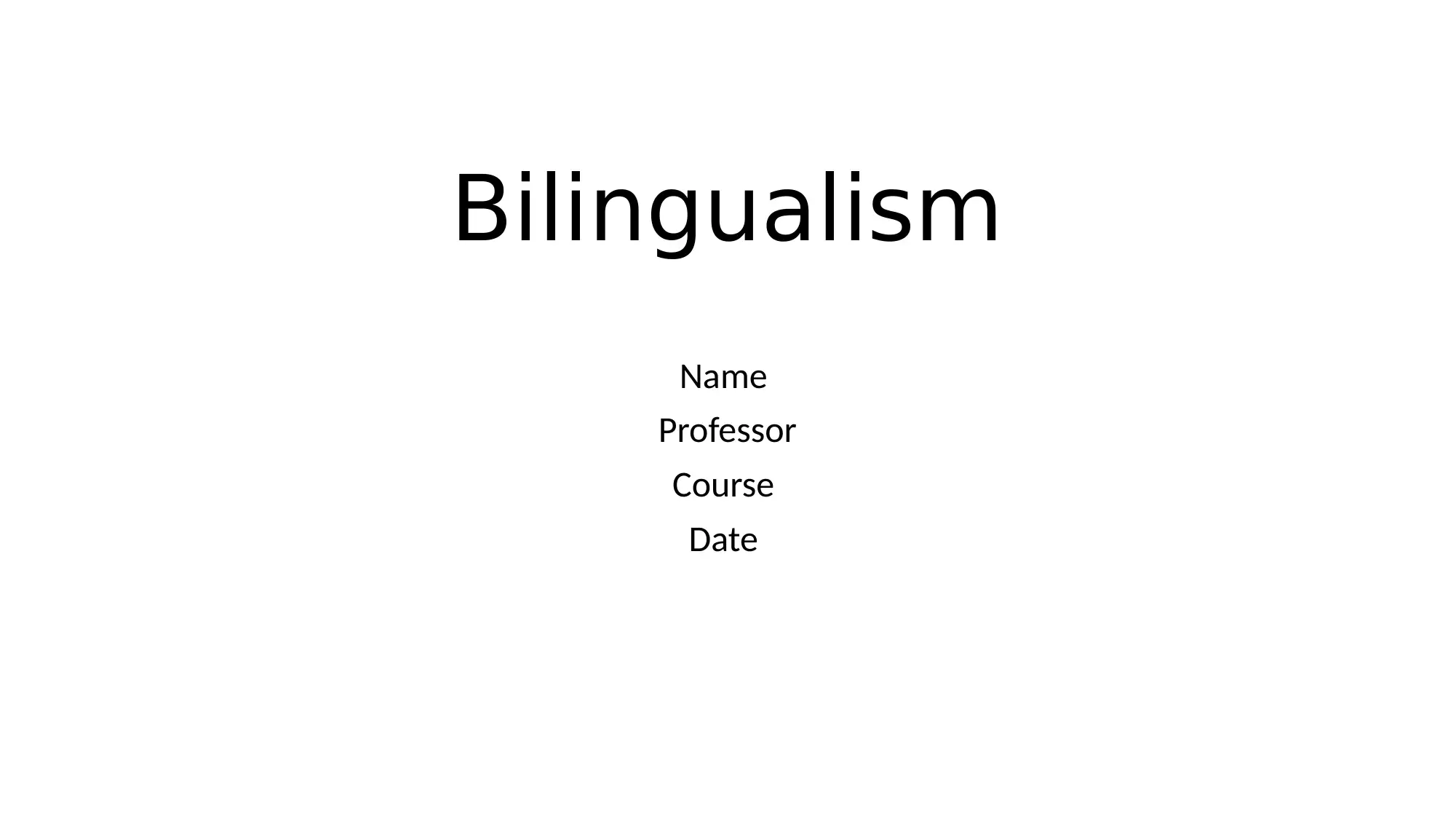
Bilingualism
Name
Professor
Course
Date
Name
Professor
Course
Date
Paraphrase This Document
Need a fresh take? Get an instant paraphrase of this document with our AI Paraphraser
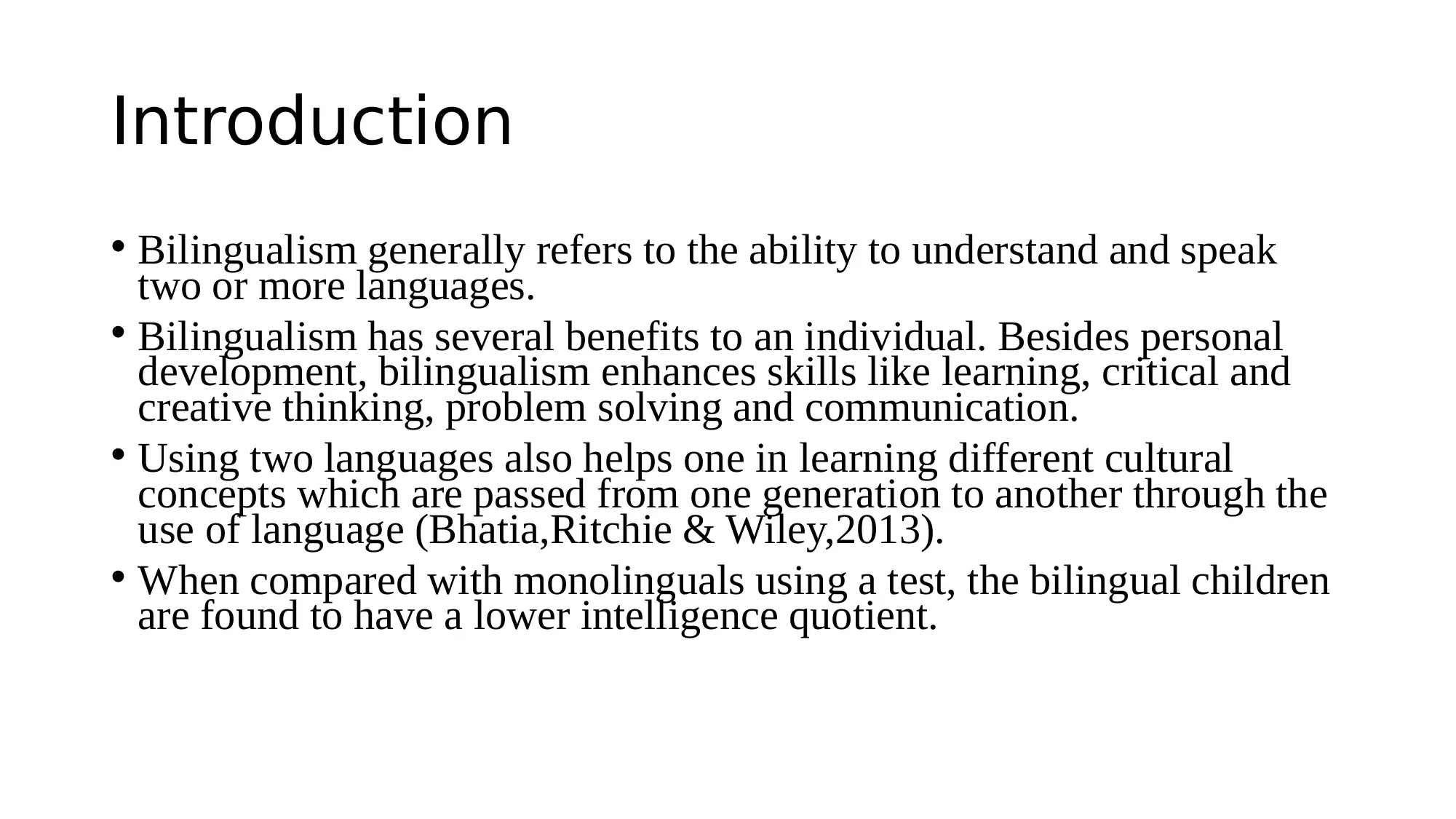
Introduction
• Bilingualism generally refers to the ability to understand and speak
two or more languages.
• Bilingualism has several benefits to an individual. Besides personal
development, bilingualism enhances skills like learning, critical and
creative thinking, problem solving and communication.
• Using two languages also helps one in learning different cultural
concepts which are passed from one generation to another through the
use of language (Bhatia,Ritchie & Wiley,2013).
• When compared with monolinguals using a test, the bilingual children
are found to have a lower intelligence quotient.
• Bilingualism generally refers to the ability to understand and speak
two or more languages.
• Bilingualism has several benefits to an individual. Besides personal
development, bilingualism enhances skills like learning, critical and
creative thinking, problem solving and communication.
• Using two languages also helps one in learning different cultural
concepts which are passed from one generation to another through the
use of language (Bhatia,Ritchie & Wiley,2013).
• When compared with monolinguals using a test, the bilingual children
are found to have a lower intelligence quotient.
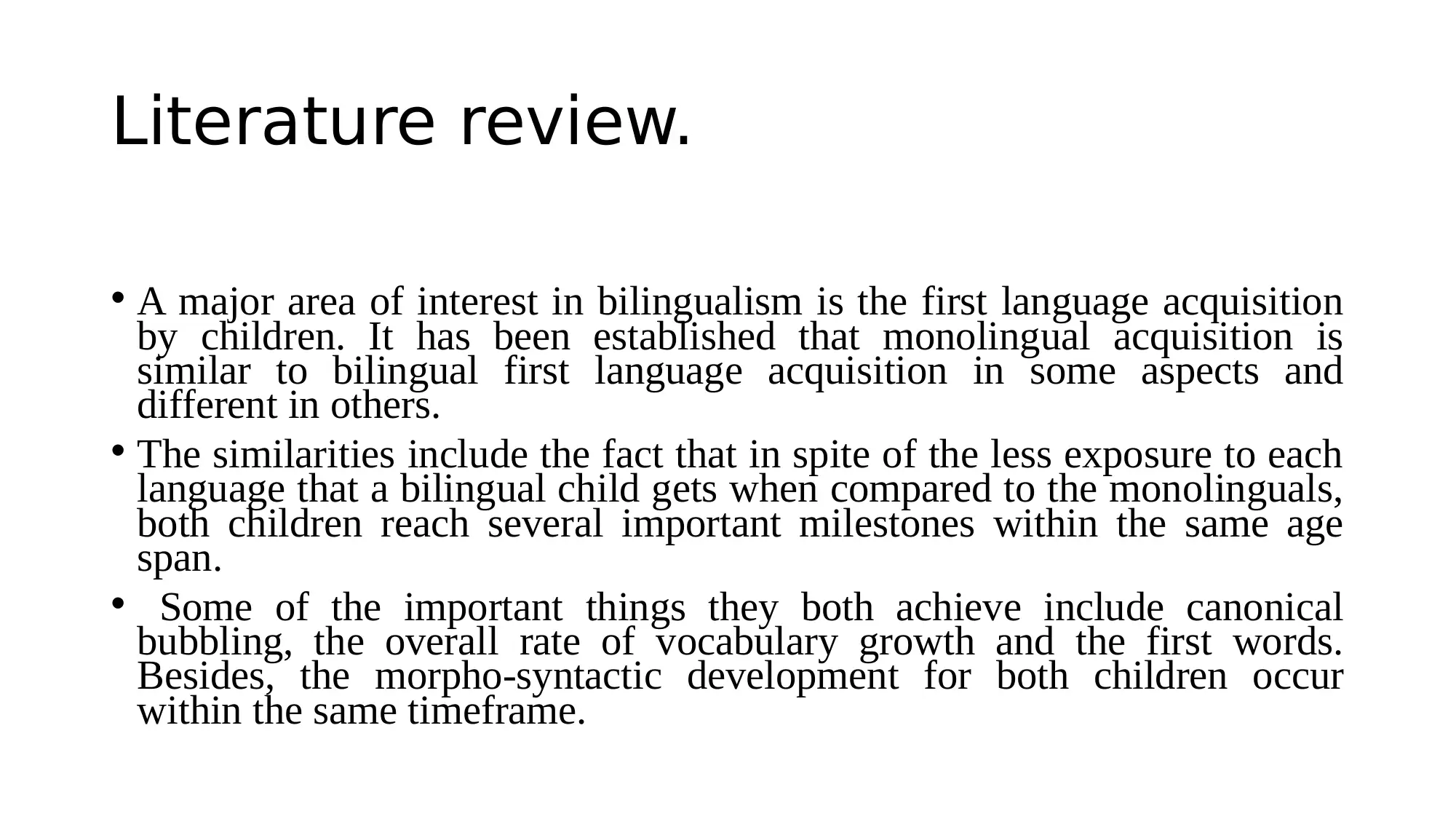
Literature review.
• A major area of interest in bilingualism is the first language acquisition
by children. It has been established that monolingual acquisition is
similar to bilingual first language acquisition in some aspects and
different in others.
• The similarities include the fact that in spite of the less exposure to each
language that a bilingual child gets when compared to the monolinguals,
both children reach several important milestones within the same age
span.
• Some of the important things they both achieve include canonical
bubbling, the overall rate of vocabulary growth and the first words.
Besides, the morpho-syntactic development for both children occur
within the same timeframe.
• A major area of interest in bilingualism is the first language acquisition
by children. It has been established that monolingual acquisition is
similar to bilingual first language acquisition in some aspects and
different in others.
• The similarities include the fact that in spite of the less exposure to each
language that a bilingual child gets when compared to the monolinguals,
both children reach several important milestones within the same age
span.
• Some of the important things they both achieve include canonical
bubbling, the overall rate of vocabulary growth and the first words.
Besides, the morpho-syntactic development for both children occur
within the same timeframe.
⊘ This is a preview!⊘
Do you want full access?
Subscribe today to unlock all pages.

Trusted by 1+ million students worldwide
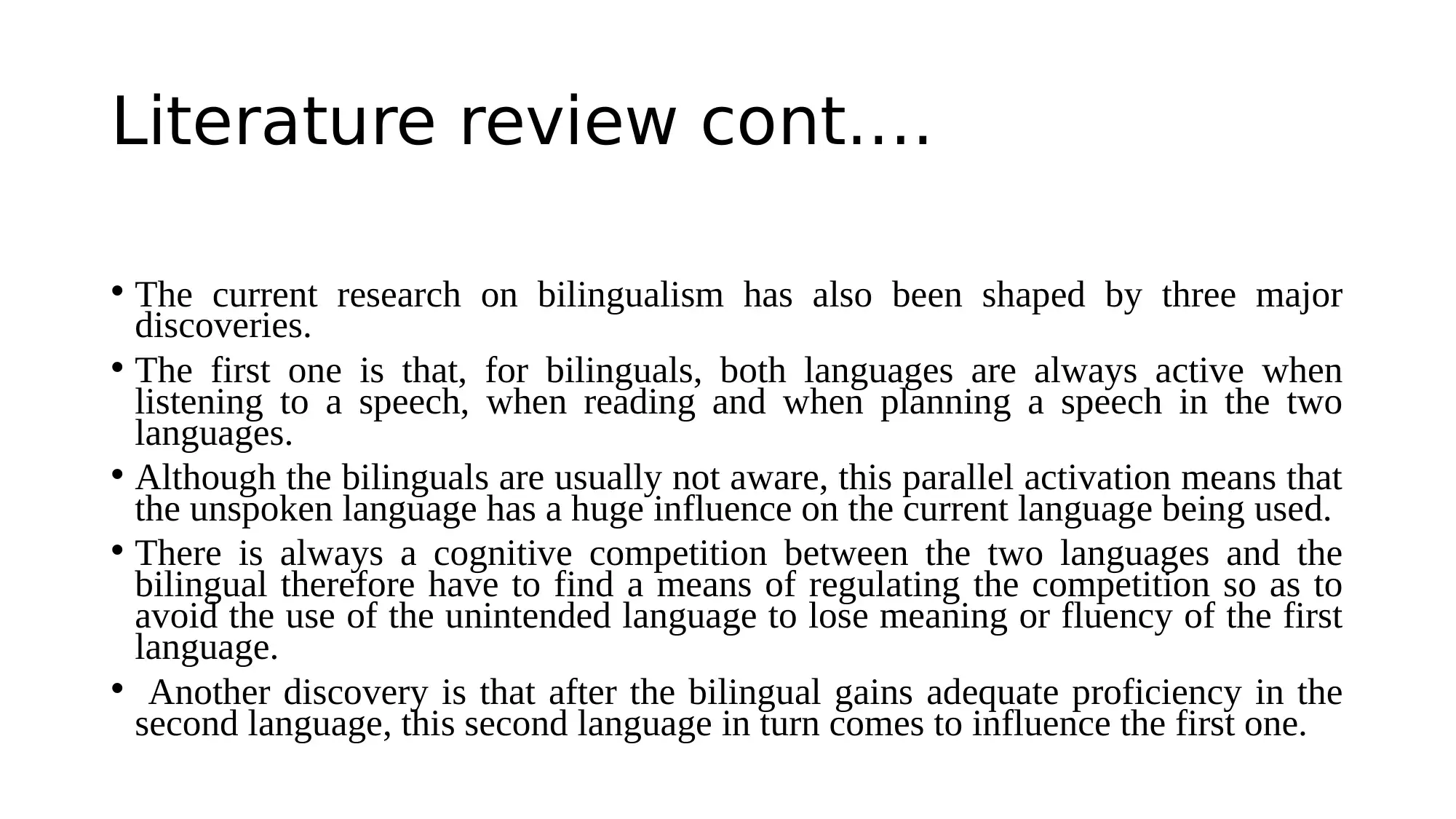
Literature review cont.…
• The current research on bilingualism has also been shaped by three major
discoveries.
• The first one is that, for bilinguals, both languages are always active when
listening to a speech, when reading and when planning a speech in the two
languages.
• Although the bilinguals are usually not aware, this parallel activation means that
the unspoken language has a huge influence on the current language being used.
• There is always a cognitive competition between the two languages and the
bilingual therefore have to find a means of regulating the competition so as to
avoid the use of the unintended language to lose meaning or fluency of the first
language.
• Another discovery is that after the bilingual gains adequate proficiency in the
second language, this second language in turn comes to influence the first one.
• The current research on bilingualism has also been shaped by three major
discoveries.
• The first one is that, for bilinguals, both languages are always active when
listening to a speech, when reading and when planning a speech in the two
languages.
• Although the bilinguals are usually not aware, this parallel activation means that
the unspoken language has a huge influence on the current language being used.
• There is always a cognitive competition between the two languages and the
bilingual therefore have to find a means of regulating the competition so as to
avoid the use of the unintended language to lose meaning or fluency of the first
language.
• Another discovery is that after the bilingual gains adequate proficiency in the
second language, this second language in turn comes to influence the first one.
Paraphrase This Document
Need a fresh take? Get an instant paraphrase of this document with our AI Paraphraser
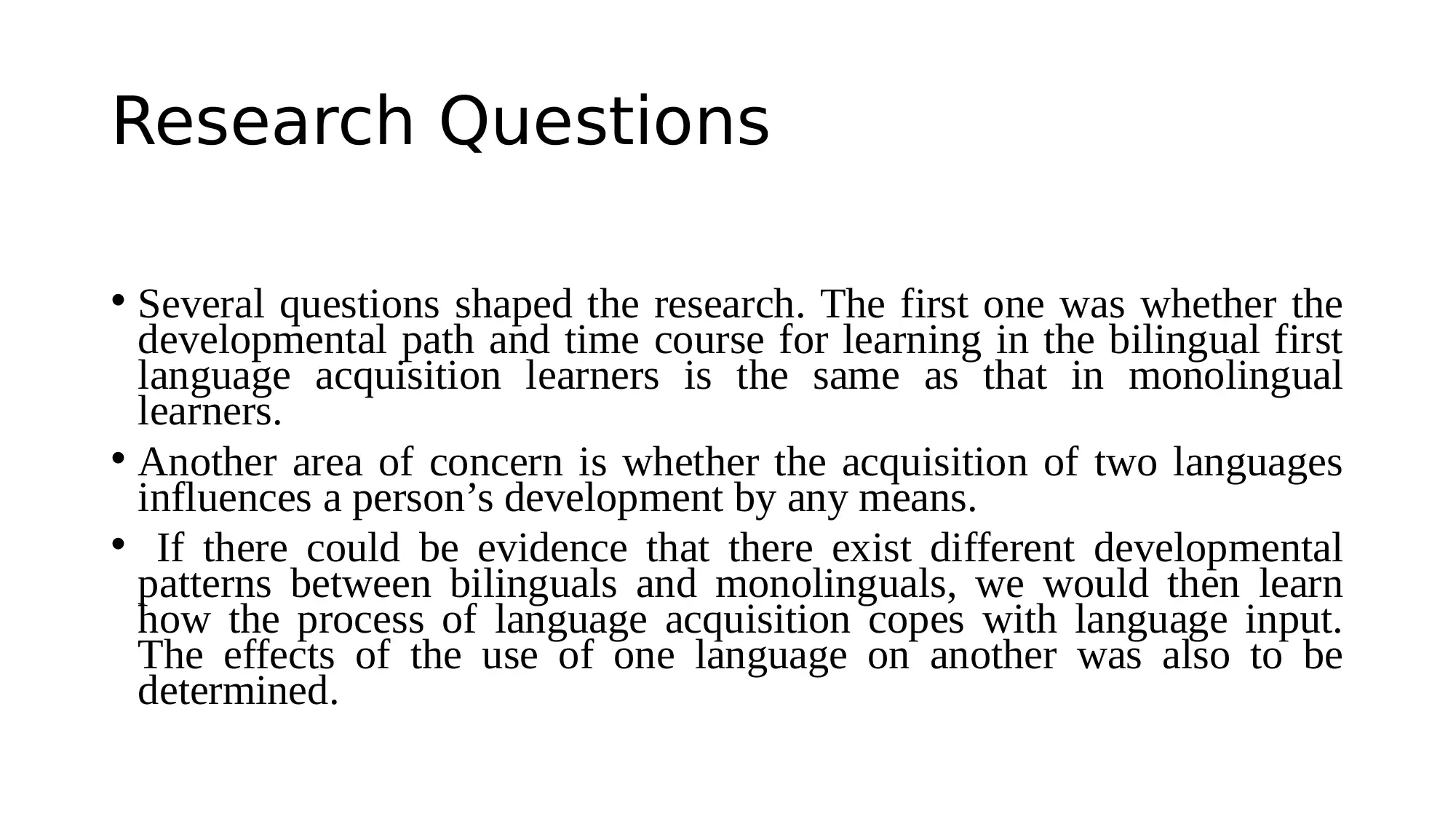
Research Questions
• Several questions shaped the research. The first one was whether the
developmental path and time course for learning in the bilingual first
language acquisition learners is the same as that in monolingual
learners.
• Another area of concern is whether the acquisition of two languages
influences a person’s development by any means.
• If there could be evidence that there exist different developmental
patterns between bilinguals and monolinguals, we would then learn
how the process of language acquisition copes with language input.
The effects of the use of one language on another was also to be
determined.
• Several questions shaped the research. The first one was whether the
developmental path and time course for learning in the bilingual first
language acquisition learners is the same as that in monolingual
learners.
• Another area of concern is whether the acquisition of two languages
influences a person’s development by any means.
• If there could be evidence that there exist different developmental
patterns between bilinguals and monolinguals, we would then learn
how the process of language acquisition copes with language input.
The effects of the use of one language on another was also to be
determined.
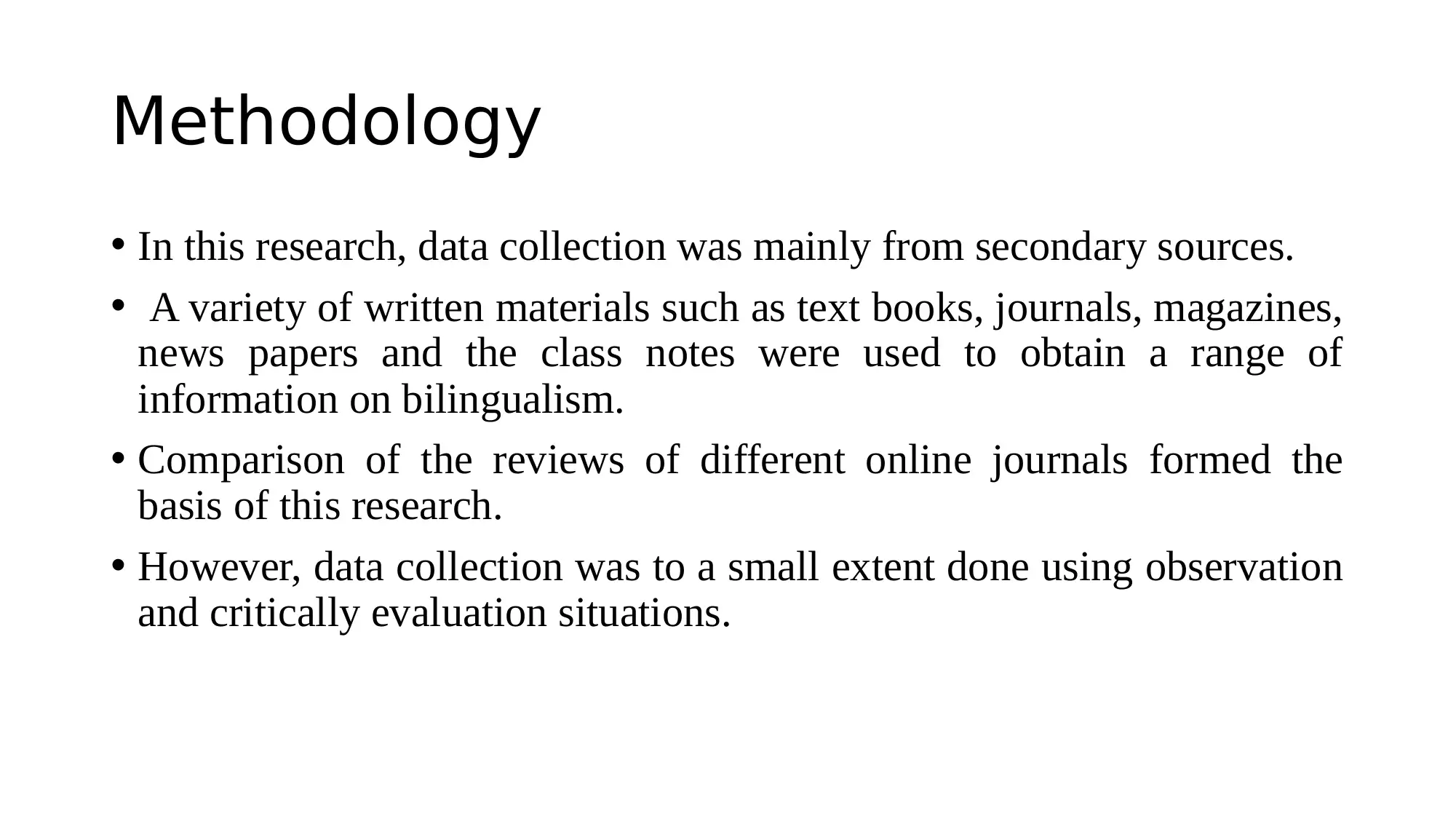
Methodology
• In this research, data collection was mainly from secondary sources.
• A variety of written materials such as text books, journals, magazines,
news papers and the class notes were used to obtain a range of
information on bilingualism.
• Comparison of the reviews of different online journals formed the
basis of this research.
• However, data collection was to a small extent done using observation
and critically evaluation situations.
• In this research, data collection was mainly from secondary sources.
• A variety of written materials such as text books, journals, magazines,
news papers and the class notes were used to obtain a range of
information on bilingualism.
• Comparison of the reviews of different online journals formed the
basis of this research.
• However, data collection was to a small extent done using observation
and critically evaluation situations.
⊘ This is a preview!⊘
Do you want full access?
Subscribe today to unlock all pages.

Trusted by 1+ million students worldwide
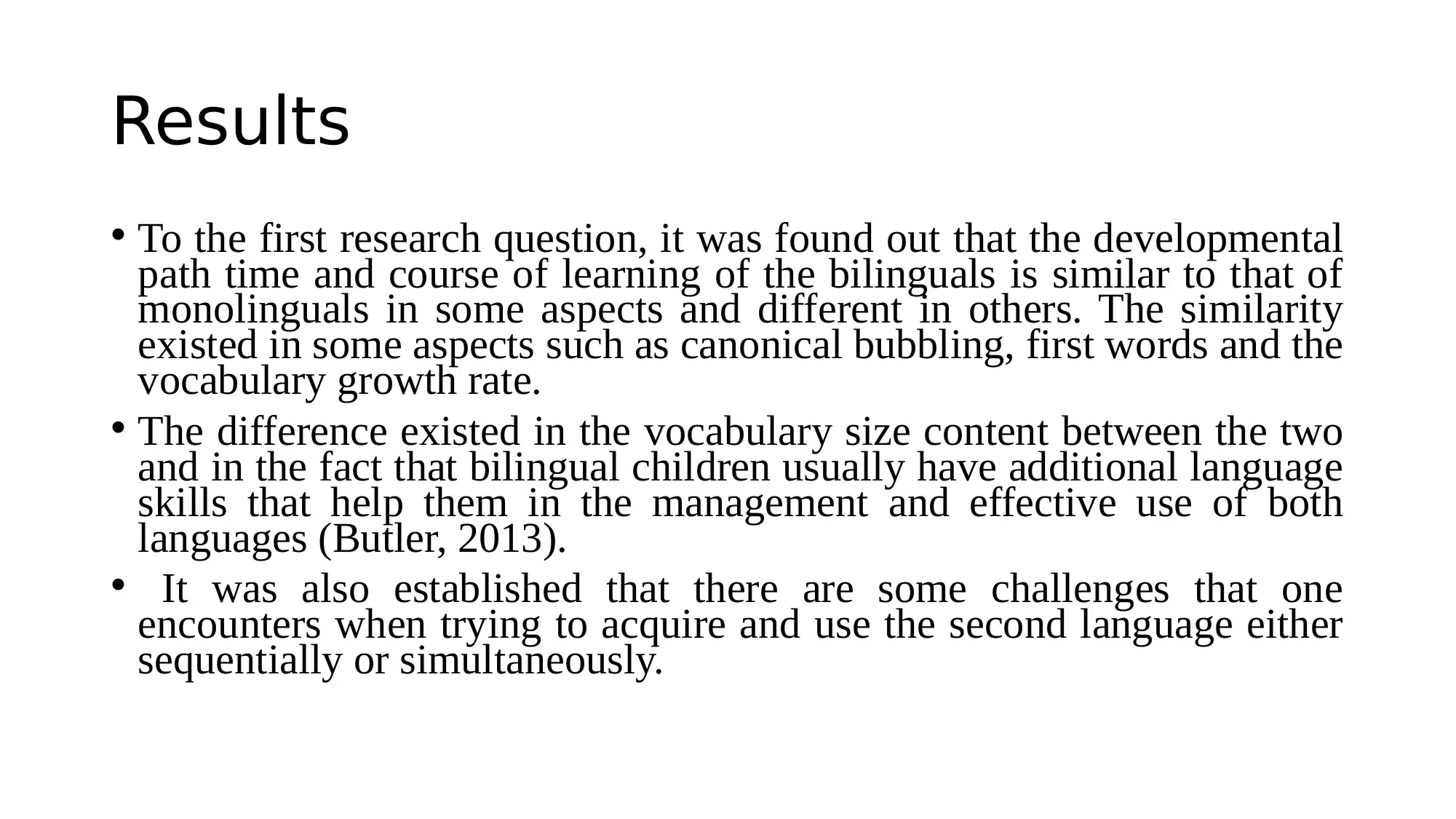
Results
• To the first research question, it was found out that the developmental
path time and course of learning of the bilinguals is similar to that of
monolinguals in some aspects and different in others. The similarity
existed in some aspects such as canonical bubbling, first words and the
vocabulary growth rate.
• The difference existed in the vocabulary size content between the two
and in the fact that bilingual children usually have additional language
skills that help them in the management and effective use of both
languages (Butler, 2013).
• It was also established that there are some challenges that one
encounters when trying to acquire and use the second language either
sequentially or simultaneously.
• To the first research question, it was found out that the developmental
path time and course of learning of the bilinguals is similar to that of
monolinguals in some aspects and different in others. The similarity
existed in some aspects such as canonical bubbling, first words and the
vocabulary growth rate.
• The difference existed in the vocabulary size content between the two
and in the fact that bilingual children usually have additional language
skills that help them in the management and effective use of both
languages (Butler, 2013).
• It was also established that there are some challenges that one
encounters when trying to acquire and use the second language either
sequentially or simultaneously.
Paraphrase This Document
Need a fresh take? Get an instant paraphrase of this document with our AI Paraphraser
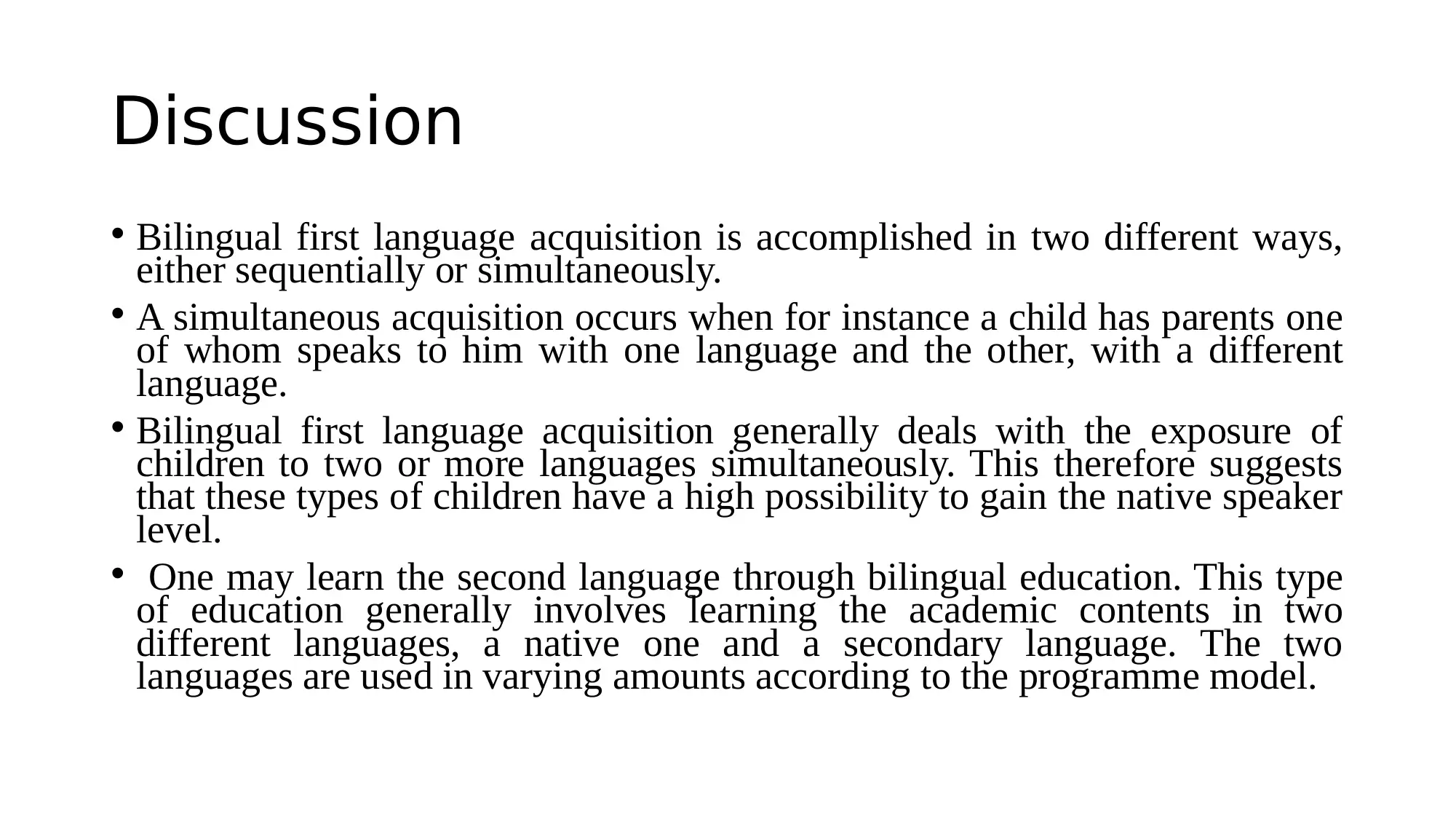
Discussion
• Bilingual first language acquisition is accomplished in two different ways,
either sequentially or simultaneously.
• A simultaneous acquisition occurs when for instance a child has parents one
of whom speaks to him with one language and the other, with a different
language.
• Bilingual first language acquisition generally deals with the exposure of
children to two or more languages simultaneously. This therefore suggests
that these types of children have a high possibility to gain the native speaker
level.
• One may learn the second language through bilingual education. This type
of education generally involves learning the academic contents in two
different languages, a native one and a secondary language. The two
languages are used in varying amounts according to the programme model.
• Bilingual first language acquisition is accomplished in two different ways,
either sequentially or simultaneously.
• A simultaneous acquisition occurs when for instance a child has parents one
of whom speaks to him with one language and the other, with a different
language.
• Bilingual first language acquisition generally deals with the exposure of
children to two or more languages simultaneously. This therefore suggests
that these types of children have a high possibility to gain the native speaker
level.
• One may learn the second language through bilingual education. This type
of education generally involves learning the academic contents in two
different languages, a native one and a secondary language. The two
languages are used in varying amounts according to the programme model.
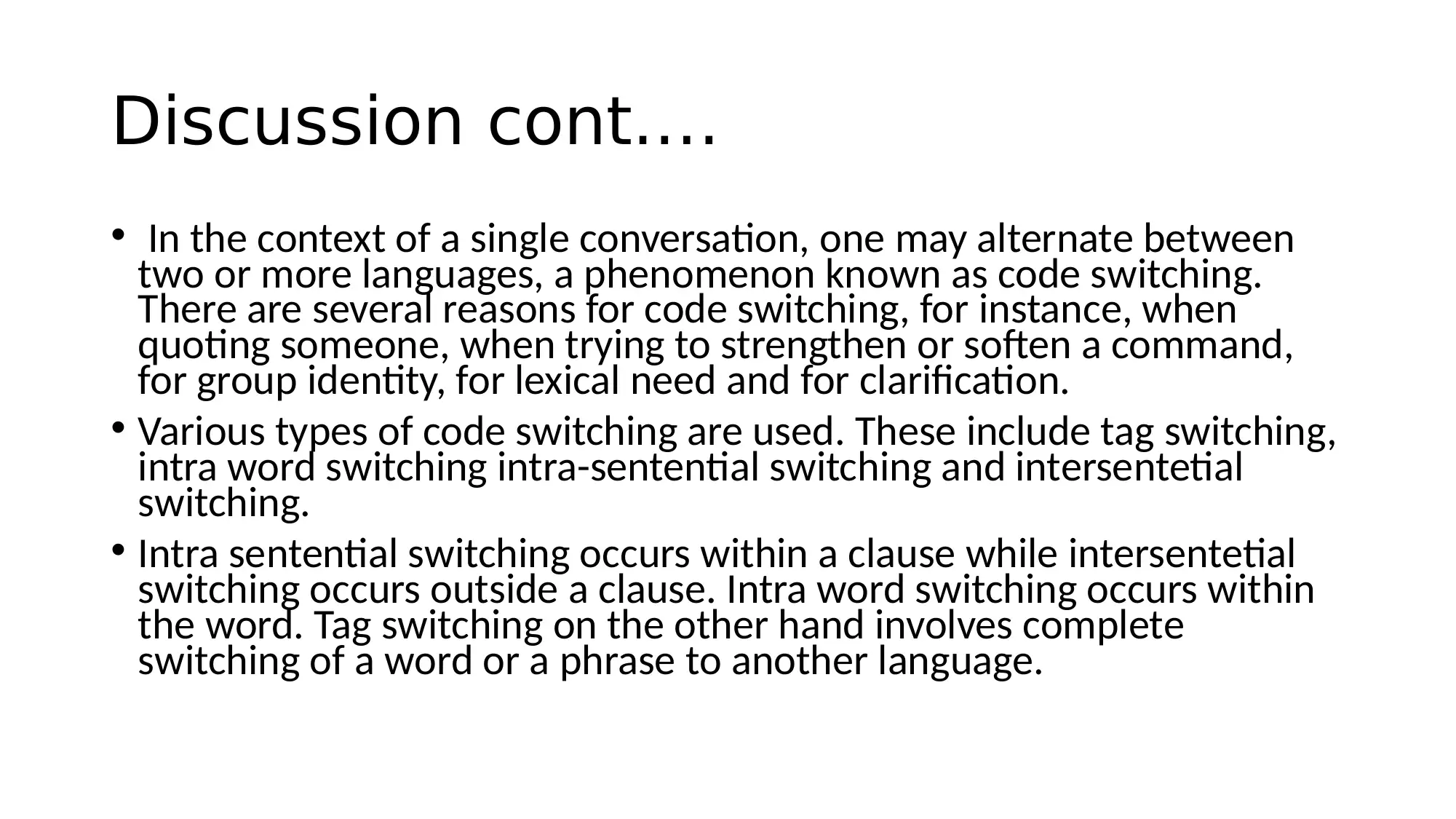
Discussion cont.…
• In the context of a single conversation, one may alternate between
two or more languages, a phenomenon known as code switching.
There are several reasons for code switching, for instance, when
quoting someone, when trying to strengthen or soften a command,
for group identity, for lexical need and for clarification.
• Various types of code switching are used. These include tag switching,
intra word switching intra-sentential switching and intersentetial
switching.
• Intra sentential switching occurs within a clause while intersentetial
switching occurs outside a clause. Intra word switching occurs within
the word. Tag switching on the other hand involves complete
switching of a word or a phrase to another language.
• In the context of a single conversation, one may alternate between
two or more languages, a phenomenon known as code switching.
There are several reasons for code switching, for instance, when
quoting someone, when trying to strengthen or soften a command,
for group identity, for lexical need and for clarification.
• Various types of code switching are used. These include tag switching,
intra word switching intra-sentential switching and intersentetial
switching.
• Intra sentential switching occurs within a clause while intersentetial
switching occurs outside a clause. Intra word switching occurs within
the word. Tag switching on the other hand involves complete
switching of a word or a phrase to another language.
⊘ This is a preview!⊘
Do you want full access?
Subscribe today to unlock all pages.

Trusted by 1+ million students worldwide
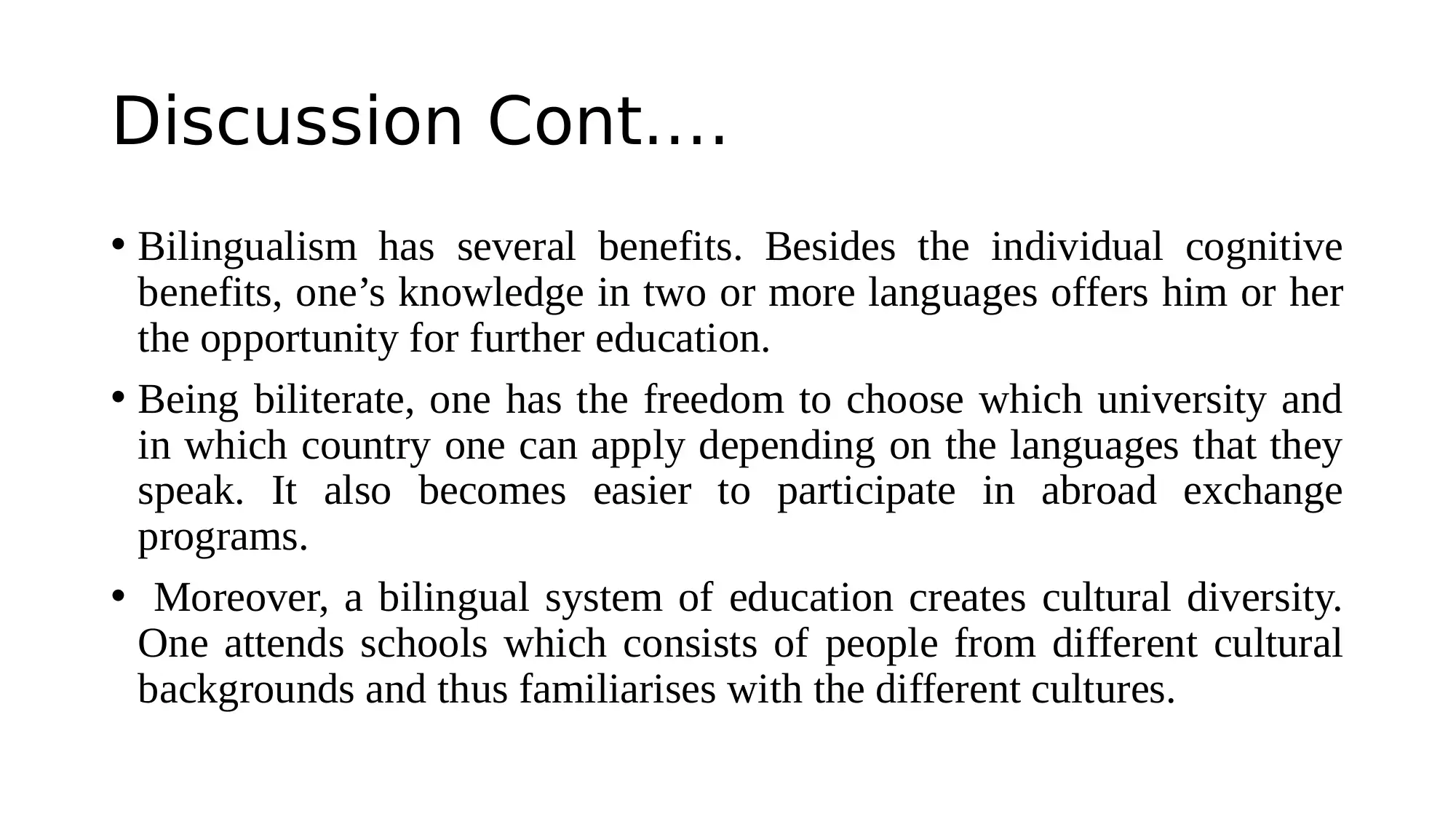
Discussion Cont.…
• Bilingualism has several benefits. Besides the individual cognitive
benefits, one’s knowledge in two or more languages offers him or her
the opportunity for further education.
• Being biliterate, one has the freedom to choose which university and
in which country one can apply depending on the languages that they
speak. It also becomes easier to participate in abroad exchange
programs.
• Moreover, a bilingual system of education creates cultural diversity.
One attends schools which consists of people from different cultural
backgrounds and thus familiarises with the different cultures.
• Bilingualism has several benefits. Besides the individual cognitive
benefits, one’s knowledge in two or more languages offers him or her
the opportunity for further education.
• Being biliterate, one has the freedom to choose which university and
in which country one can apply depending on the languages that they
speak. It also becomes easier to participate in abroad exchange
programs.
• Moreover, a bilingual system of education creates cultural diversity.
One attends schools which consists of people from different cultural
backgrounds and thus familiarises with the different cultures.
Paraphrase This Document
Need a fresh take? Get an instant paraphrase of this document with our AI Paraphraser
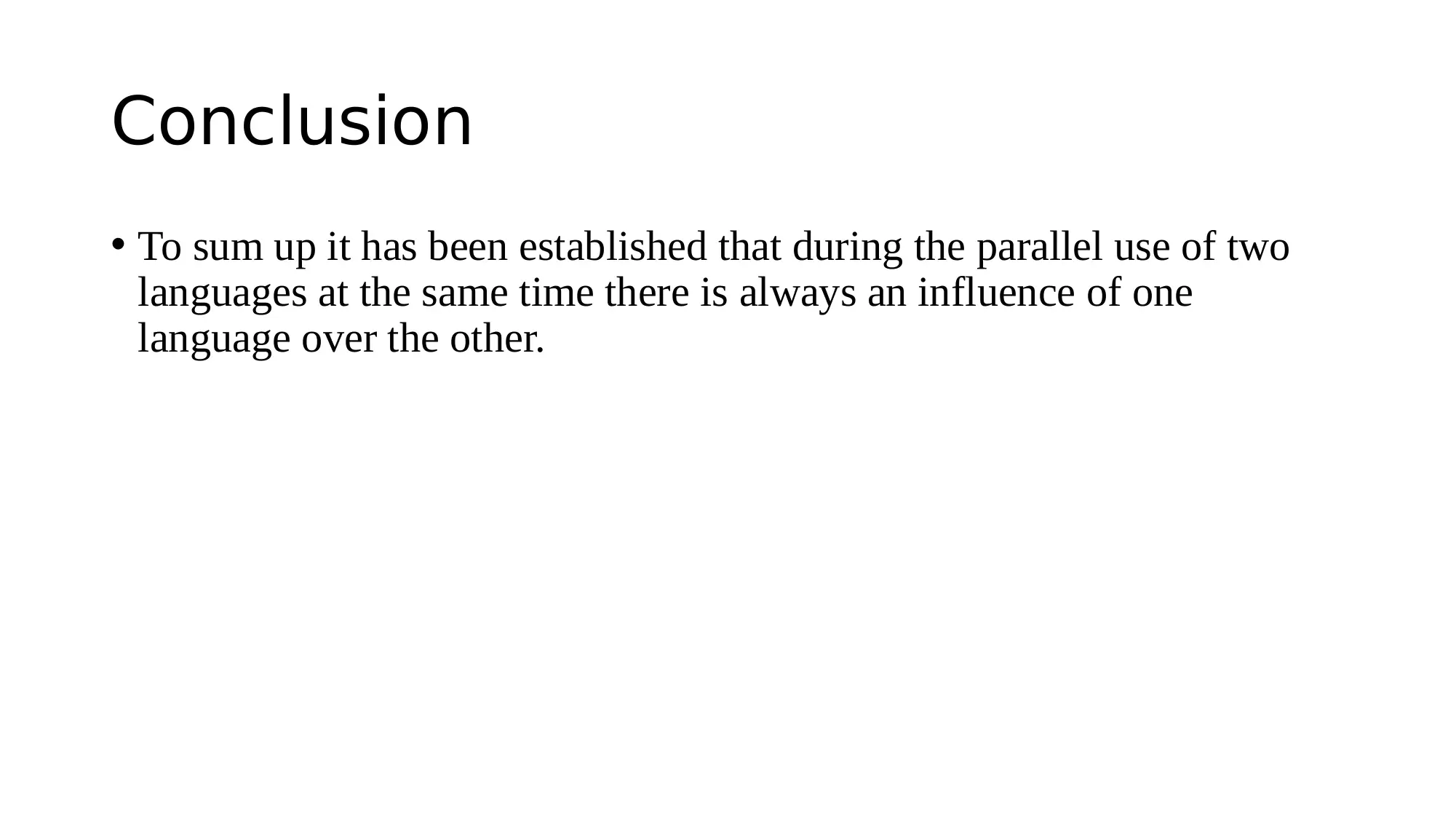
Conclusion
• To sum up it has been established that during the parallel use of two
languages at the same time there is always an influence of one
language over the other.
• To sum up it has been established that during the parallel use of two
languages at the same time there is always an influence of one
language over the other.
1 out of 11
Related Documents
Your All-in-One AI-Powered Toolkit for Academic Success.
+13062052269
info@desklib.com
Available 24*7 on WhatsApp / Email
![[object Object]](/_next/static/media/star-bottom.7253800d.svg)
Unlock your academic potential
Copyright © 2020–2025 A2Z Services. All Rights Reserved. Developed and managed by ZUCOL.




